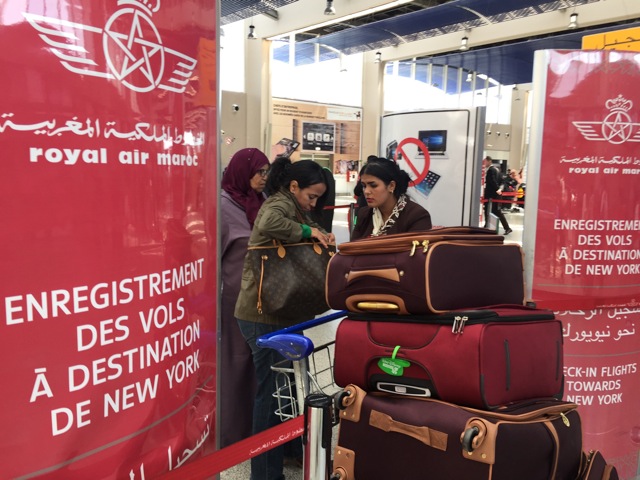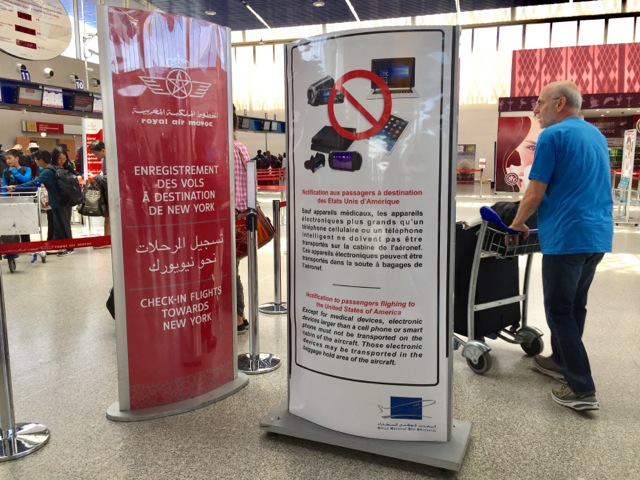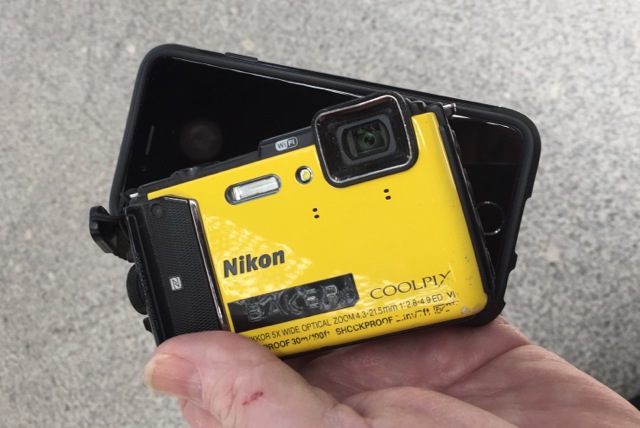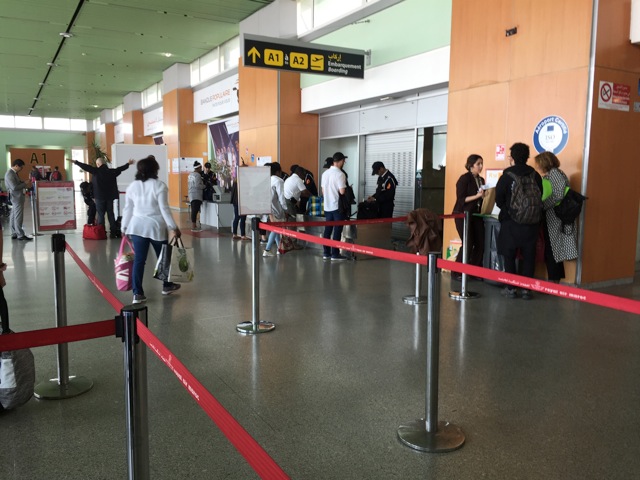How the Electronics Ban Really Plays Out: A First-Hand Account
 A staffer for Royal Air Maroc warns New York–bound passengers about the electronics ban. Photo: Tim Baker
A staffer for Royal Air Maroc warns New York–bound passengers about the electronics ban. Photo: Tim Baker When Homeland Security announced an electronics ban on flights from (and through) certain Middle Eastern airports, I had advice to share — see my article A Pro Photographer’s Solutions to the Airline Electronics Ban — but a lot of questions too. That’s because I needed to fly with all my camera gear on one of the flights affected by the ban. I just got back. Here’s what happened and what I learned.
I had no problem bringing electronic items into Morocco. The problem was getting them back to the States, since I was flying Royal Air Maroc from Casablanca (one of the affected airports) to New York. Luckily, Wendy was flying back from Morocco on a different route (via Europe) with no ban, so she carried my most expensive camera gear in her carry-on. She had no issues whatsoever. But here’s what happened when I arrived at Casablanca airport with the remainder of my gear.

Signage about the electronics ban at the Royal Air Maroc check-in desk. Photo: Tim Baker
At Casablanca’s Mohammed V International Airport, the check-in area for New York–bound passengers was roped off from other flights. At the entrance, an official asked each passenger whether they had electronics in their carry-on and advised them to move these items to their checked baggage. I had already packed my remaining camera and lenses in my checked bag, but as a test I’d left my smallest camera in my carry-on. This compact camera is about the same size as a cell phone, and the Homeland Security website states:
Electronic devices larger than a cell phone/smart phone will not be allowed to be carried onboard the aircraft in carry-on luggage or other accessible property. Electronic devices that exceed this size limit must be secured in checked luggage.

My compact camera made it through without being questioned. Photo: Tim Baker
The New York-bound passengers were co-mingled with other international fliers for the security checkpoint, which went exceptionally smoothly. Too smoothly, I thought, considering that it was operating under a heightened alert.
At the gate, I was at the end of a long line of passengers. Six security staffers were rummaging through each carry-on bag. The man inspecting my bag missed my compact camera, and I was green-lighted. My children, Charlie and Doug, were carrying their Nintendo DS game consoles with them in their backpacks. The inspector missed Doug’s but found Charlie’s. He showed it to several other inspectors and got mixed answers. Several times he returned it to the backpack and looked ready to send us on our way. After several minutes of confusion and consternation, he called over a supervisor, and it was finally determined that the game console could not be in the cabin.
Charlie and his console were then directed to a staffer at a small table, where the game console was placed in an individual padded paper pouch. Charlie was given a baggage claim check. The pouch was placed with a dozen others, including several laptops. He retrieved it at baggage claim at JFK. Of course, all this time, Doug’s exact same Nintendo DS game console had been allowed to remain in his carry-on.

At the gate. The staffer on the right is packaging confiscated items to be put in the baggage hold of the plane. Photo: Tim Baker
Here are my three biggest takeaways from this experience of the electronics ban:
* The rules are way too vague, and thus enforcement is inconsistent. Too much is left to the discretion of individual inspectors.
* At affected airports, you may find long lines for U.S.-bound passengers. So, if you’re hoping to get something to eat or buy last-minute souvenirs at the airport, get there even earlier than planned.
* Like certain other affected airlines, Royal Air Maroc has a good system for handling devices that are confiscated during the final inspection and ensuring they are returned safe and sound to passengers after the flight.
Be a smarter traveler: Use Wendy’s WOW List to plan your next trip. You can also follow her on Facebook, Twitter @wendyperrin, and Instagram @wendyperrin, and sign up for her weekly newsletter to stay in the know.









It would be helpful to know a few more things …how did he pack his gear in his checked bag? Are we talking Pelican hard cases? How did it fare? More details about the padded paper bag for the game console? A photo showing how much padding, how large, are there different sizes, etc would be helpful. IF he had to go through the exact same situation again, would he still take the chance and pack his gear in his checked luggage, or would he use the padded bag system and gate check his gear as his son did?
Michelle,
Here are answers from my husband Tim (who wrote the article):
When I need to pack a stray piece of equipment that won’t fit in my carry-on, I usually just wrap it in my clothes and make sure it is positioned (and stays) in the center of the bag. Of course I use a TSA-approved lock on it. We tend to worry about the packaging around our equipment, but consider how they are shipped from the factory in Japan. Did you save the original packaging? Considering reusing it in some form. After all, its what the factory used. They weren’t shipped to your camera store in a hard, waterproof, shock-proof case — just a cardboard box.
Sure, photos of the whole process at the Casablanca airport would have been helpful, but you aren’t allowed to take photos of the security process. This is true in the US too. So, afraid of getting hassled just as I was about to leave the country with several thousand images, I didn’t do a full photo report. Also, in many of the countries on the list, things could change rapidly. They might have run out of padded paper bags right after we left. I just don’t know. Because, I don’t think the airports know either.
As for packing my gear again, I think I’d go with a Pelican-type hard case and use an international freight courier. Pay the extra insurance and hope for the best.